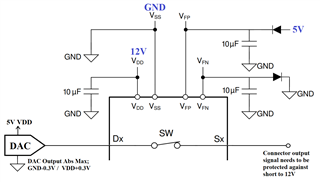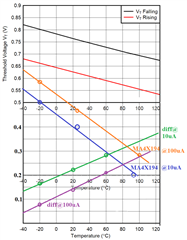Hi,
TMUX7462F protects from overvoltage beyond the VFP+VT
I need to protect a 5V level signal with GND-0.3V to 5V+0.3V (absolute max) range.
If I connect VPF pin to 5V supply, max voltage on the signal can go up to 5.7V before cut off.
Do I need additional 4.6V supply (or divider+buffer) to supply VFP?
Or can I do this with a simple series 0.4V~0.5V forward voltage drop diode on the 5V supply line? And maybe one more series diode needed for the VFN pin also to protect GND-0.3V?
(TMUX7462F will be supplied by 12V signle supply.)
And a second question when will be available this device in the stocks?
Regards,
Mete



